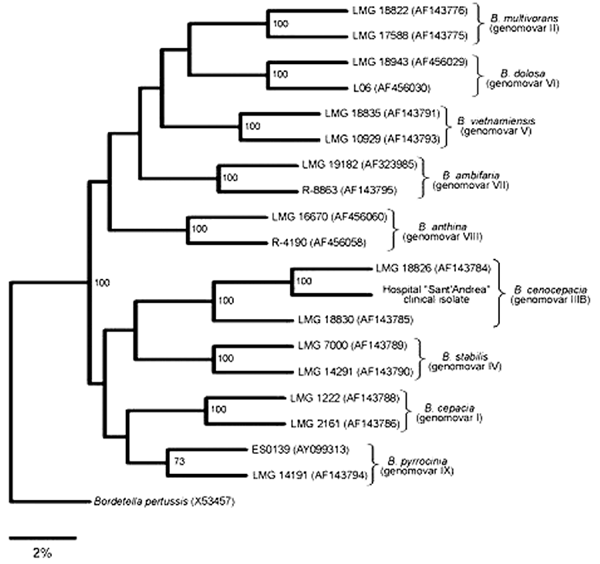Volume 10, Number 11—November 2004
Dispatch
Burkholderia cenocepacia Vaginal Infection in Patient with Smoldering Myeloma and Chronic Hepatitis C
Figure

Figure. The consensus phylogenetic tree of recA DNA sequences of Burkholderia cepacia complex strains, representative of each genomovar, and of the B. cenocepacia isolate (GenBank accession no. AJ786367) was constructed with the PHYLIP package (version 3.6) (http://evolution.genetics.washington.edu/phylip.html). Only recA DNA sequences of reference B. cenocepacia strains (genomovar III, lineage IIIB) are included in the tree (4,13). Alignments were performed with the Clustal W program. Genetic distance is indicated on the scale, and bootstrap analysis for nodes values >70% are shown. GenBank accession numbers of the recA DNA sequences are shown for each reference strains.
References
- Gillan PH, Whittier S. Burkholderia, Stenotrophomonas, Ralstonia, Brevundimonas, Comamonas and Acidovorax In: Murray PR, Baron EJ, Pfaller MA, Tenover FC, Yolker RH, editors. Manual of clinical microbiology. Washington: American Society of Microbiolgy; 1999. p. 526–38.
- Coenye T, Vandamme P. Diversity and significance of Burkholderia species occupying diverse ecological niches. Environ Microbiol. 2003;5:719–29. DOIPubMedGoogle Scholar
- Coenye T. LiPuma JJ. Molecular epidemiology of Burkholderia species. Front Biosci. 2003;8:e55–67. DOIPubMedGoogle Scholar
- Vandamme P, Holmes B, Coenye T, Goris J, Mahenthiralingam E. LiPuma JJ, Govan JRW. Burkholderia cenocepacia sp. nov.—a new twist to an old story. Res Microbiol. 2003;154:91–6. DOIPubMedGoogle Scholar
- Speert DP, Henry DA, Vandamme P, Corey M, Mahenthiralingam E. Epidemiology of Burkholderia cepacia complex in patients with cystic fibrosis, Canada. Emerg Infect Dis. 2002;8:181–7.PubMedGoogle Scholar
- Agodi A, Mahenthiralingam E, Bachitta M, Giannino V, Sciacca A, Stefani S. Burkholderia cepacia complex infection in Italian patients with cystic fibrosis: prevalence, epidemiology, and genomovar status. J Clin Microbiol. 2001;39:2891–6. DOIPubMedGoogle Scholar
- LiPuma JJ. Spilker T, Gill GH, Campbell PW, Liu L, Mahenthiralingam E. Disproportionate distribuition of Burkholderia cepacia complex species and transmissibility markers in cystic fibrosis. Am J Respir Crit Care Med. 2001;164:92–6.PubMedGoogle Scholar
- Coenye T, Vandamme P, Govan JRW. LiPuma JJ. Taxonomy and identification of the Burkholderia cepacia complex. J Clin Microbiol. 2001;39:3427–36. DOIPubMedGoogle Scholar
- Nzula S, Vandamme P, Govan JR. Influence of taxonomic status on the in vitro antimicrobial susceptibility of the Burkholderia cepacia complex. J Antimicrob Chemother. 2002;50:265–9. DOIPubMedGoogle Scholar
- Henry DA, Mahenthiralingam E, Vandamme P, Coenye T, Speert DP. Phenotypic methods for determining genomovar status of the Burkholderia cepacia complex. J Clin Microbiol. 2001;39:1073–8. DOIPubMedGoogle Scholar
- Vandamme P, Henry D, Coenye T, Nzula S, Vancanneyt M, LiPuma JJ, et al. Burkholderia anthina sp. nov. and Burkholderia pyrrocinia, two additional Burkholderia cepacia complex bacteria, may confound results of new molecular diagnostic tools. FEMS Immunol Med Microbiol. 2002;33:143–9. DOIPubMedGoogle Scholar
- Vermis K, Coenye T, Mahenthiralingam E, Nelis HJ, Vandamme P. Evaluation of species-specific recA-based PCR tests for genomovar level identification within the Burkholderia cepacia complex. J Med Microbiol. 2002;51:937–40.PubMedGoogle Scholar
- Mahenthiralingam E, Bischof J, Byrne SK, Radomski C, Davies JE, Av-Gay Y, DNA-based diagnostic approaches for the identification of Burkholderia cepacia complex, Burkholderia vietnamiensis, Burkholderia multivorans, Burkholderia stabilis, Burkholderia cepacia genomovars I and III. J Clin Microbiol. 2000;38:3165–73.PubMedGoogle Scholar
- Petrucca A, Cipriani P, Valenti P, Santapaola D, Cimmino C, Scoarughi GL, Molecular characterization of Burkholderia cepacia isolates from cystic fibrosis (CF) patients in an Italian CF center. Res Microbiol. 2003;154:491–8. DOIPubMedGoogle Scholar
- Siddiqui AH, Mullingam ME, Mahenthiralingam E, Hebden J, Brewrink J, Qaiyumi S, An episodic outbreak of genetically related Burkholderia cepacia among non–cystic fibrosis patients at a university hospital. Infect Control Hosp Epidemiol. 2001;22:419–22. DOIPubMedGoogle Scholar
Page created: May 03, 2011
Page updated: May 03, 2011
Page reviewed: May 03, 2011
The conclusions, findings, and opinions expressed by authors contributing to this journal do not necessarily reflect the official position of the U.S. Department of Health and Human Services, the Public Health Service, the Centers for Disease Control and Prevention, or the authors' affiliated institutions. Use of trade names is for identification only and does not imply endorsement by any of the groups named above.